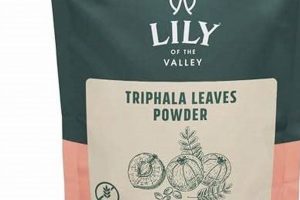These preparations encompass a variety of plant-derived substances marketed to alleviate symptoms associated with arthritis. These formulations are available in multiple forms, including capsules, tablets, teas, and topical creams, and are intended to complement or serve as alternatives to conventional medical treatments. Examples include turmeric, ginger, and boswellia, each promoted for its potential anti-inflammatory properties.
The use of botanicals in managing joint discomfort has a long history, often rooted in traditional medicine systems across different cultures. Proponents suggest these substances offer a more natural approach, potentially with fewer adverse effects than some pharmaceutical options. The appeal lies in their perceived ability to address inflammation and pain, key factors affecting quality of life for individuals experiencing arthritic conditions.
The following sections will delve into the scientific evidence supporting the efficacy of specific botanical extracts, potential risks and interactions, considerations for appropriate usage, and a comparison with standard medical therapies. Further investigation into the safety profile and regulatory landscape surrounding these products will also be provided.
Guidance on Botanical Formulations for Arthritic Conditions
The following provides important considerations for individuals exploring botanical options for managing arthritis symptoms. Thorough research and consultation with healthcare professionals are crucial.
Tip 1: Prioritize Consultation with a Qualified Healthcare Provider. A physician or qualified healthcare professional can assess individual health status, existing medications, and potential interactions before initiating any new supplement regimen.
Tip 2: Research Specific Botanical Ingredients. Investigate the scientific evidence supporting the efficacy of individual herbs. Peer-reviewed studies and reputable sources provide valuable insights into potential benefits and limitations.
Tip 3: Be Aware of Potential Drug Interactions. Certain botanicals can interact with prescription and over-the-counter medications, potentially altering their effectiveness or increasing the risk of adverse effects. Inform the healthcare provider of all substances being consumed.
Tip 4: Understand the Importance of Standardized Extracts. Opt for products containing standardized extracts to ensure consistent potency and the presence of active compounds in predictable concentrations.
Tip 5: Consider the Route of Administration. Topical applications may provide localized relief for specific joints, while oral supplements offer a systemic approach. The optimal method depends on the type and location of arthritic symptoms.
Tip 6: Monitor for Adverse Reactions. Closely observe the body’s response after starting a new botanical product. Discontinue use and seek medical attention if any unusual or concerning symptoms develop.
Tip 7: Purchase Products from Reputable Manufacturers. Select brands that adhere to Good Manufacturing Practices (GMP) and provide transparent information about their sourcing, processing, and quality control procedures.
Adherence to these guidelines can help ensure a safer and more informed approach when incorporating botanical options into an arthritis management plan. Individual results may vary, and these products are not a substitute for conventional medical care.
The subsequent sections will explore potential risks, dosages and further guidance.
1. Anti-inflammatory Properties
The appeal of botanical extracts in managing arthritic conditions largely stems from their purported anti-inflammatory properties. Chronic inflammation is a hallmark of many forms of arthritis, contributing to pain, stiffness, and joint damage. Therefore, substances capable of modulating inflammatory pathways are of significant interest.
- Modulation of Cytokine Production
Many herbal constituents are believed to influence the production of cytokines, signaling molecules that play a key role in the inflammatory cascade. Certain botanicals may suppress pro-inflammatory cytokines like TNF-alpha and IL-1beta, while potentially promoting anti-inflammatory cytokines. This modulation aims to shift the balance away from chronic inflammation.
- Inhibition of Inflammatory Enzymes
Specific botanical compounds may inhibit enzymes involved in the inflammatory process, such as cyclooxygenase (COX) and lipoxygenase (LOX). These enzymes are responsible for the synthesis of prostaglandins and leukotrienes, respectively, both of which contribute to inflammation and pain. Inhibition of these enzymes is a common mechanism of action for many anti-inflammatory drugs.
- Antioxidant Activity
Oxidative stress, caused by an imbalance between free radicals and antioxidant defenses, can exacerbate inflammation in arthritic joints. Certain botanicals possess antioxidant properties, neutralizing free radicals and reducing oxidative damage. This protective effect may contribute to a reduction in inflammation and pain.
- Impact on Immune Cell Function
Immune cells, such as T cells and macrophages, play a critical role in the pathogenesis of many forms of arthritis. Some botanical extracts may influence the activity of these immune cells, modulating their inflammatory responses and potentially reducing joint damage. However, the precise mechanisms and long-term effects on immune function require further investigation.
These various mechanisms suggest potential pathways through which botanical extracts might exert anti-inflammatory effects in arthritic conditions. However, it is essential to acknowledge that the scientific evidence supporting these mechanisms varies considerably among different botanicals. Furthermore, the bioavailability, optimal dosage, and potential adverse effects of these extracts require careful consideration and further research to establish their true therapeutic potential.
2. Pain Management Potential
Botanical substances are frequently investigated for their capacity to alleviate pain associated with arthritis. The chronic pain experienced by individuals with arthritis significantly impacts their quality of life, motivating the exploration of diverse treatment modalities. These supplements are proposed as a means to mitigate pain through various mechanisms, including anti-inflammatory effects, modulation of pain pathways, and potential analgesic properties.
Many botanical preparations, such as those containing ginger or capsaicin, are believed to exert their pain-relieving effects by influencing pain signaling pathways. Capsaicin, for instance, can desensitize nerve endings, reducing the transmission of pain signals. Ginger, similarly, exhibits anti-inflammatory properties that may contribute to a decrease in pain perception. The efficacy of these supplements can vary among individuals, and the level of pain relief achieved may not be comparable to that provided by conventional analgesics. The practical application lies in their potential as adjuncts to traditional therapies, or as alternatives for individuals seeking to avoid or minimize the use of pharmaceutical pain relievers.
In summary, the potential of botanical extracts to manage arthritic pain represents a significant area of ongoing research and clinical interest. While some preparations show promise in reducing pain symptoms, the evidence remains incomplete, and further investigation is necessary to fully understand their efficacy and safety. Individuals considering these options should consult with healthcare professionals to determine the most appropriate course of action for their specific condition.
3. Source and Standardization
The efficacy and safety of botanical products for arthritis management are critically dependent on the origin of the raw materials and the standardization of the final extract. The geographical location, growing conditions, and harvesting practices significantly influence the chemical composition of a medicinal plant. For instance, turmeric grown in different regions may exhibit varying concentrations of curcuminoids, the active compounds responsible for its anti-inflammatory effects. Similarly, the presence of contaminants, such as heavy metals or pesticides, can be affected by the cultivation environment, potentially posing health risks. Therefore, knowing the source of the botanical is paramount in assessing its suitability for therapeutic use.
Standardization refers to the process of ensuring consistent levels of specific bioactive compounds in each batch of a product. This is achieved through careful extraction and quality control procedures. Standardized extracts guarantee that consumers receive a predictable dose of the active ingredient, improving the likelihood of achieving the desired therapeutic effect. For example, a standardized boswellia extract might be guaranteed to contain a specific percentage of boswellic acids, known for their anti-inflammatory activity. Products lacking standardization may contain unpredictable levels of active compounds, rendering them ineffective or potentially harmful due to inconsistent dosing.
In conclusion, the source and standardization of herbal products intended for arthritis are non-negotiable aspects of quality and safety. Consumers should prioritize products from reputable manufacturers who provide transparent information about the origin of their raw materials and the standardization processes employed. Third-party testing and certification can further validate the quality and purity of these products, providing an additional layer of assurance. Choosing wisely based on source and standardization significantly enhances the potential benefits and minimizes the risks associated with these remedies.
4. Potential Drug Interactions
The concurrent use of botanicals and pharmaceutical medications presents a significant area of concern due to the potential for pharmacological interactions. These interactions can alter the efficacy or safety profiles of either the botanical or the drug, leading to unexpected adverse effects or therapeutic failures. Understanding the mechanisms and clinical implications of these interactions is critical for healthcare providers and individuals considering integrating botanical options into their arthritis management plan.
- Cytochrome P450 Enzyme Modulation
Many botanicals can influence the activity of cytochrome P450 (CYP) enzymes, a family of enzymes responsible for metabolizing a significant portion of pharmaceutical drugs. Some botanicals may inhibit CYP enzymes, leading to increased drug concentrations and a higher risk of toxicity. Conversely, others may induce CYP enzymes, resulting in decreased drug concentrations and reduced therapeutic effectiveness. For instance, St. John’s Wort is a well-known CYP3A4 inducer, potentially decreasing the effectiveness of immunosuppressants commonly used in rheumatoid arthritis management.
- Pharmacodynamic Interactions
Pharmacodynamic interactions occur when botanicals and drugs have additive or antagonistic effects on the same physiological system. For example, combining a botanical with anticoagulant properties, such as high-dose ginger or garlic, with warfarin or other blood thinners can increase the risk of bleeding. Similarly, using a botanical with sedative effects alongside prescription sedatives may potentiate drowsiness and impair cognitive function. Awareness of these additive or opposing effects is essential to avoid adverse outcomes.
- Impact on Drug Absorption
Certain botanicals can affect the absorption of drugs in the gastrointestinal tract. For example, the presence of tannins or fiber in some herbal preparations may bind to drugs, reducing their absorption and bioavailability. This is particularly relevant for drugs with narrow therapeutic windows, where even small changes in absorption can significantly impact clinical outcomes. Co-administration of botanicals and medications should be carefully timed to minimize potential interference with drug absorption.
- Electrolyte and Mineral Interactions
Botanicals can influence electrolyte and mineral balance, potentially interacting with medications that also affect these parameters. For example, diuretics are often prescribed for edema associated with arthritis. Combining diuretics with botanicals that also have diuretic effects can lead to excessive fluid loss and electrolyte imbalances, such as hypokalemia. Monitoring electrolyte levels and adjusting medication dosages may be necessary to prevent adverse effects.
These examples highlight the complexity of potential drug interactions associated with the use of botanical arthritis supplements. While some interactions may be mild and clinically insignificant, others can be serious and require immediate medical attention. Open communication between patients and healthcare providers regarding the use of both conventional medications and botanical products is crucial for identifying and managing potential drug interactions, ensuring the safety and efficacy of the overall treatment regimen.
5. Limited clinical evidence
The assertion of limited clinical evidence regarding herbal arthritis supplements is a crucial consideration. It underscores the need for caution and critical evaluation when assessing the potential benefits and risks of these products. While anecdotal reports and traditional use may suggest efficacy, rigorous scientific validation is often lacking.
- Small Sample Sizes in Studies
Many studies evaluating botanical supplements for arthritis involve small sample sizes, which can limit the statistical power and generalizability of the results. Small studies are more susceptible to random errors and may not accurately reflect the true effect of the supplement in a broader population. Furthermore, the results of small studies may not be applicable to diverse patient populations with varying demographics and disease characteristics.
- Lack of Standardized Methodologies
Significant variability exists in the methodologies employed in clinical trials of herbal arthritis supplements. Differences in study designs, outcome measures, dosages, and duration of treatment make it difficult to compare results across studies and draw definitive conclusions. The absence of standardized methodologies also hinders the development of evidence-based guidelines for the use of these supplements.
- Publication Bias
A potential for publication bias exists in the scientific literature regarding herbal arthritis supplements. Studies with positive results are more likely to be published than those with negative or inconclusive findings. This bias can create a skewed impression of the effectiveness of these supplements, leading to overestimation of their benefits and underestimation of their risks.
- Variability in Product Quality and Composition
The inconsistent quality and composition of herbal supplements pose a challenge to clinical research. Differences in sourcing, processing, and standardization can lead to variations in the levels of active compounds in different products. This variability makes it difficult to determine the true efficacy of a specific botanical and can complicate the interpretation of clinical trial results.
In conclusion, the limited clinical evidence base for herbal arthritis supplements necessitates a cautious approach. While some studies suggest potential benefits, the methodological limitations, publication bias, and product variability hinder the establishment of firm conclusions. Individuals considering these supplements should carefully weigh the potential benefits against the risks, consulting with healthcare professionals to make informed decisions based on the best available evidence.
Frequently Asked Questions about Herbal Arthritis Supplements
This section addresses common inquiries regarding the use of botanical preparations for managing arthritis symptoms. The information provided aims to offer clarity and guidance based on current scientific understanding.
Question 1: Are herbal arthritis supplements a substitute for conventional medical treatment?
Herbal supplements are generally not considered a replacement for conventional medical interventions for arthritis. Pharmaceutical drugs and physical therapy often form the cornerstone of arthritis management, particularly for inflammatory and autoimmune forms of the disease. Botanical preparations may serve as complementary therapies, potentially alleviating symptoms and improving quality of life when used in conjunction with, but not instead of, established medical protocols. Consultation with a healthcare provider is essential to determine the appropriate course of treatment.
Question 2: How can the safety of herbal arthritis supplements be ensured?
Ensuring the safety of botanical arthritis supplements requires careful attention to several factors. Selecting products from reputable manufacturers that adhere to Good Manufacturing Practices (GMP) is paramount. Thoroughly reviewing the list of ingredients and researching potential interactions with existing medications is critical. Initiating use with a low dose and gradually increasing it, while closely monitoring for adverse effects, can help mitigate risks. Consultation with a qualified healthcare professional is strongly recommended before starting any new supplement regimen.
Question 3: What is the appropriate dosage for herbal arthritis supplements?
The appropriate dosage varies significantly depending on the specific botanical, the individual’s health status, and the severity of arthritis symptoms. General dosage recommendations are often provided on product labels, but these should be viewed as starting points rather than definitive guidelines. Consulting with a healthcare provider or a qualified herbalist is crucial for determining the optimal dosage, taking into account individual factors and potential drug interactions. Self-adjusting dosages without professional guidance is discouraged.
Question 4: How long does it take to experience the effects of herbal arthritis supplements?
The time required to experience noticeable effects varies depending on the individual, the specific botanical used, and the consistency of use. Some individuals may experience symptom relief within a few weeks, while others may require several months of consistent use. It’s important to maintain realistic expectations and understand that botanical supplements are generally not fast-acting remedies. If no improvement is observed after a reasonable period (e.g., 2-3 months), reassessment of the treatment plan and consultation with a healthcare provider may be necessary.
Question 5: Are there specific types of arthritis for which herbal supplements are more effective?
The effectiveness of herbal supplements can vary depending on the type of arthritis. Some botanicals may show more promise for osteoarthritis, characterized by joint degeneration, while others may be more suitable for inflammatory forms of arthritis, such as rheumatoid arthritis. Researching the specific evidence supporting the use of particular botanicals for different types of arthritis is important. Consulting with a healthcare provider experienced in integrative medicine can help determine the most appropriate options based on the individual’s diagnosis and symptoms.
Question 6: What are the potential long-term effects of using herbal arthritis supplements?
The long-term effects of using herbal supplements for arthritis are not always well-established due to the limitations of long-term clinical studies. While some botanicals have a long history of traditional use, this does not guarantee their safety for prolonged use. Potential long-term effects can include liver or kidney toxicity, alterations in hormone levels, and changes in the absorption or metabolism of other medications. Regular monitoring of health parameters and open communication with a healthcare provider are crucial for assessing and managing potential long-term risks.
In summary, the use of botanical preparations requires careful consideration of potential benefits, risks, and interactions. Consulting with qualified healthcare professionals and engaging in thorough research is essential for informed decision-making.
The following section will address further guidance.
Herbal Arthritis Supplements
This exploration has revealed that while herbal arthritis supplements hold appeal for those seeking alternative or complementary approaches to managing joint discomfort, a discerning perspective is paramount. The evidence supporting their efficacy remains varied, and the potential for interactions with conventional medications necessitates careful consideration. Factors such as source, standardization, and individual health status must be rigorously evaluated.
The responsible integration of botanical substances into an arthritis management plan hinges upon informed decision-making. Ongoing research is vital to clarify the true therapeutic potential and long-term safety profile of these preparations. Individuals are encouraged to prioritize consultation with qualified healthcare professionals to navigate the complexities and ensure that any use of herbal arthritis supplements aligns with their overall health needs and objectives. The path to effective arthritis management requires diligence, informed choices, and a commitment to evidence-based practices.







